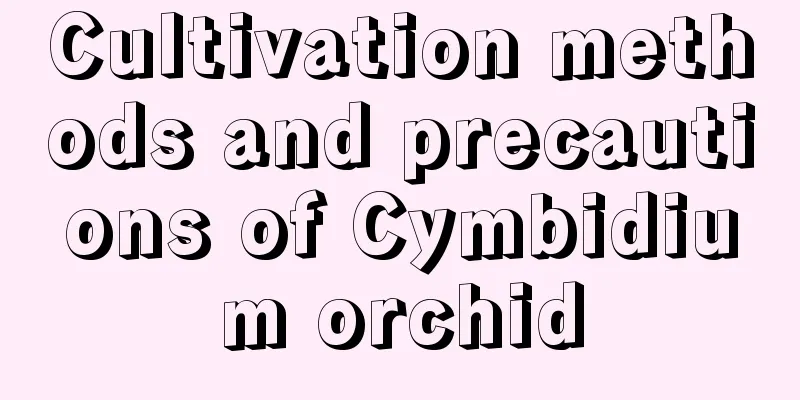Cultivation methods and precautions of Cymbidium orchid

|
Cymbidium orchid, also known as cicada orchid, Himbil orchid, and Simpson orchid, is a general term for varieties of orchids that are bred through artificial hybridization, with large flowers and bright colors. Let's talk about the cultivation methods and precautions of Cymbidium orchid. 1. Soil Cymbidium requires a well-drained, loose and breathable growing medium . It can be planted in leaf mold, or a mixture of fern roots, charcoal chips, moss, charcoal, broken bricks, bark blocks, etc. It is not suitable to use the culture soil for growing Chinese orchids or ordinary culture soil for planting. Poorly drained and aerated soil can lead to root rot. 2. Watering Cymbidium orchids prefer higher air humidity. In spring, summer and autumn, while giving the roots sufficient water, the leaves should be sprayed with water frequently. However, after flowering in early spring, the Cymbidium orchid must be watered less during its short dormant period, and only be watered more when the new buds grow larger new roots. 3. Sunlight Cymbidium requires sufficient diffuse light to grow. In summer and autumn, use a shading net to provide about 50% shade. In winter and spring when the sunlight is soft or on cloudy days, open the shading net to allow direct sunlight. However, during the flowering period, the orchid should be placed in a place with weaker light so that it can bloom brightly. 4. Temperature It likes cool summers and warm winters, and the suitable temperature for growth is 10℃ to 25℃. The night temperature should be around 10℃, especially during the flowering period, the temperature should be maintained above 5℃ and below 15℃, which can extend the flowering period by more than 3 months. 5. Fertilization During the growth period, thin fertilizers should be applied frequently. You can apply thin compound fertilizers or chemical fertilizers. If you apply decomposed bean cake fertilizer and more bone meal, you can make the flowers bigger and more numerous. Liquid fertilizer should be diluted at 1:1000 and applied once every 10 days. Sufficient fertilizer should be applied before flowering. Do not apply fertilizer in midsummer and during the flowering period. 6. Pests If the cultivation environment of Cymbidium is poor, it is easy to be harmed by diseases and insects. Common diseases include fusarium disease, soft rot, black rot, gray mold, anthracnose, white rot, etc., so it is necessary to spray fungicides once every half a month to prevent the occurrence of diseases. Special attention should also be paid to the cleaning of environmental hygiene, planting materials, water sources, and utensils. 7. Pruning The pseudobulbs of Cymbidium orchids generally contain more than 4 leaf buds. In order to prevent the nutrients from being dispersed, its growth points and new buds must be completely removed. This operation should start from the end of the flowering period, and buds should be picked once a month until the new flowering period stops. This will strengthen the mother bulb, concentrate nutrients, and make the flowers bloom more and larger. That’s it |
<<: How to care for the newly bought yellow rose
>>: How to take care of the newly bought six-fold profit
Recommend
The legend of Eucommia ulmoides
The legend of Eucommia ulmoides Eucommia ulmoides...
How to grow geraniums by cuttings? Which month is the best for cuttings?
1. How to take cuttings 1. Cutting branches: Stro...
How to grow peppers and the price of peppers
1. How to plant 1. Prepare the soil: Before plant...
The difference between tuberose and Mirabilis jalapa
1. Different plant types Tuberose is a shrub of t...
Wolfberry planting technology
1. Land planning, leveling and improvement Land p...
How to propagate figs
Cutting propagation Cuttings are usually carried ...
How to fertilize the green radish to make it grow more vigorously?
Like Chlorophytum comosum, Chlorophytum comosum i...
How long is the growth cycle of peony?
Introduction to Peony Growth Peony is suitable fo...
Caterpillars grew in her flowerpot, but they came back to life by pinching off some branches, and the entire pot was full in one month!
What does white sandalwood look like? Some people...
What is Cistanche deserticola? Pictures of Cistanche deserticola
1. What is Cistanche deserticola Cistanche desert...
What vegetables are suitable to grow in April? (What vegetables are best to grow in April?)
What vegetables are suitable to plant in April? I...
How to transplant mint seedlings
1. Transplanting time When transplanting mint see...
What to do if rose root rots
1. Remove the plant There are many reasons for ro...
How to plant fern in a balcony pot
Cultivating seedlings Ferns can be propagated in ...
Can meat be grown hydroponically?
Can meat be grown hydroponically? Succulents refe...









